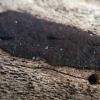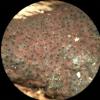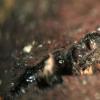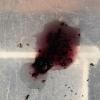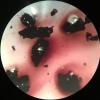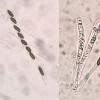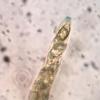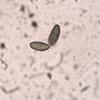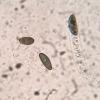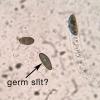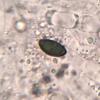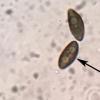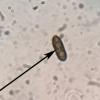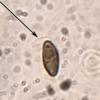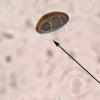
25-11-2019 21:05
 Robin Isaksson
Robin Isaksson
Spores round 3.5-4.5 um smooth it seems. Asci is

26-11-2019 18:41
François BartholomeeusenHello forum members,On October 15, 2019, I found s

26-11-2019 19:23
This Hysterial grew on stems of Phragmites austral

27-11-2019 07:24
Björn NordénHi all,Could you please help with this? It was fou

19-11-2019 17:10
 Lothar Krieglsteiner
Lothar Krieglsteiner
This was collected 14.11.19, in National Park Efel

25-11-2019 23:48
In the tiny 2-3 mm long hirsute leaves of this pla

19-12-2017 17:43
Fruitbody ca. 1 mm.Growing on the bark of living t
Hypoxylon submonticulosum ?
Ethan Crenson,
15-01-2020 22:42
Hello,
Last weekend in New York City I collected an effuse Hypoxylon on decorticated hardwood that had purple KOH-extractable pigments. I looked in Ju and Rogers and found that there are few North American Hypoxylon species that have that feature. I thought perhaps this could be Hypoxylon submonticulosum.
The surface pigment is dark brick red. The ostioles are higher than the stromatal layer. There are no colored granules just below the surface of the stroma. There is a small but visible layer of stroma below the perithecia.
Asci are 112-137 x 7.5-8.5µm with the spore bearing part 76-86µm. Apical ring is IKI+.
Spores measure 9-13 x 4-5µm, ellipsoid/inequalateral-ellipsoid with tapered ends, brown or light brown (it seems there were not a lot of mature spores, leading me to believe that this could be a young specimen). There are usually 2 to 3 oil droplets. It is very difficult to detect if there is a germ slit, but I think I saw one which is almost full spore length.
There is note in Ju and Rogers which indicates that for both H. monticulosum and H. submonticulosum there can be a purple KOH pigment reaction "only in the young stromata", otherwise there is none. I checked the reaction twice. At home under artificial light the reaction is less purple and more dark red/burgundy.
Does anyone, particularly Jacques Fournier (!) have any thoughts on this possible Hypoxylon submonticulosum?
Thanks in advance,
Ethan
Jacques Fournier,
16-01-2020 16:06

Re : Hypoxylon submonticulosum ?
Hi Ethan,
I agree with you, your fungus meets all the key features of H. submonticulosum. Just reaction of perispore to KOH is missing but it is difficult to assess in this species. The germ slit is also often more conspicuous in KOH.
For your information, this fungus was recently excluded from Hypoxylon and moved to the new genus Hypomontagnella (Lambert et al. 2018). I send you the paper privately.
All my best,
Jacques
Ethan Crenson,
16-01-2020 17:21
Re : Hypoxylon submonticulosum ?
Jacques,
Thank you for your help! I just prepared another slide and I was able to detect the reaction of the perispore in KOH and also saw clearer view of the germ slit. Now I can see that it is clearly less than spore length. Thank you also for the paper. My collection keyed rather nicely to Hypomontagnella submonticulosa.
Best regards,
Ethan
Jacques Fournier,
16-01-2020 18:37

Re : Hypoxylon submonticulosum ?
excellent observations! the germ slit is clearly shorter than the spore length, and the perispores are indeed dehiscing but thin-walled and smooth, making them easily overlooked.
Your collection conforms absolutely well to H. submonticulosa.
Cheers,
Jacques


